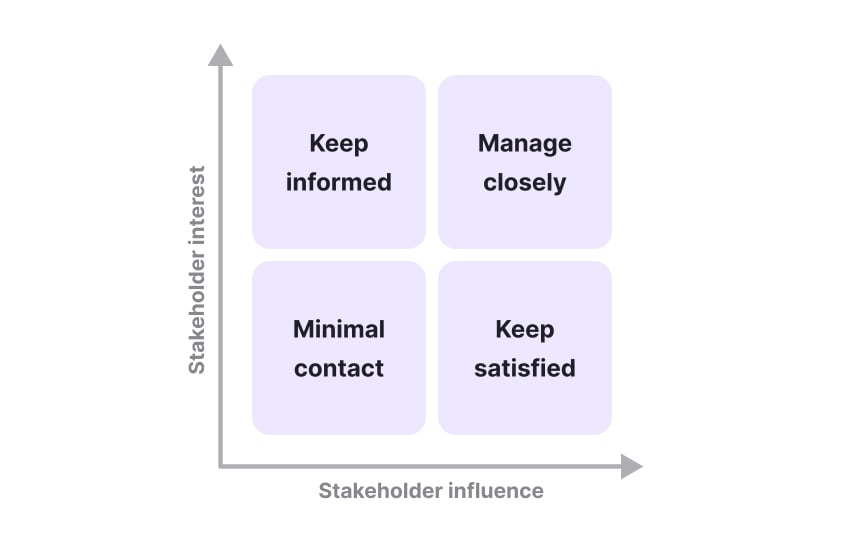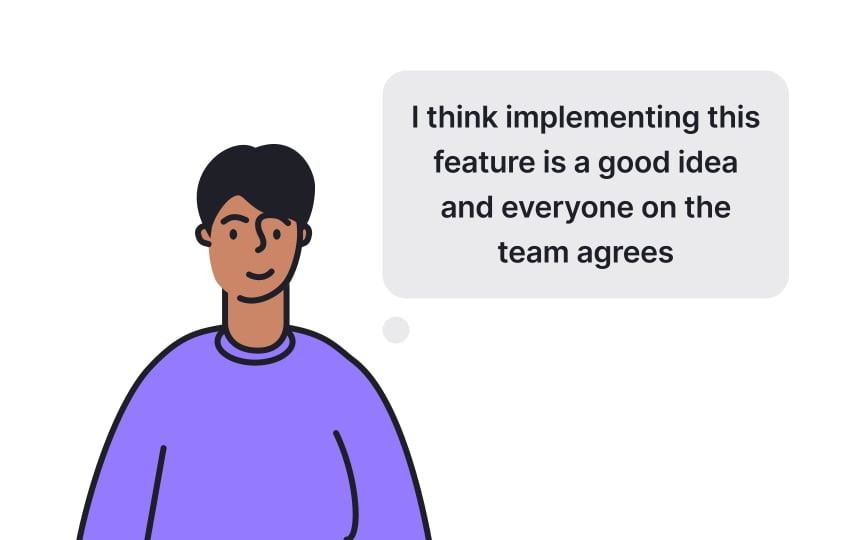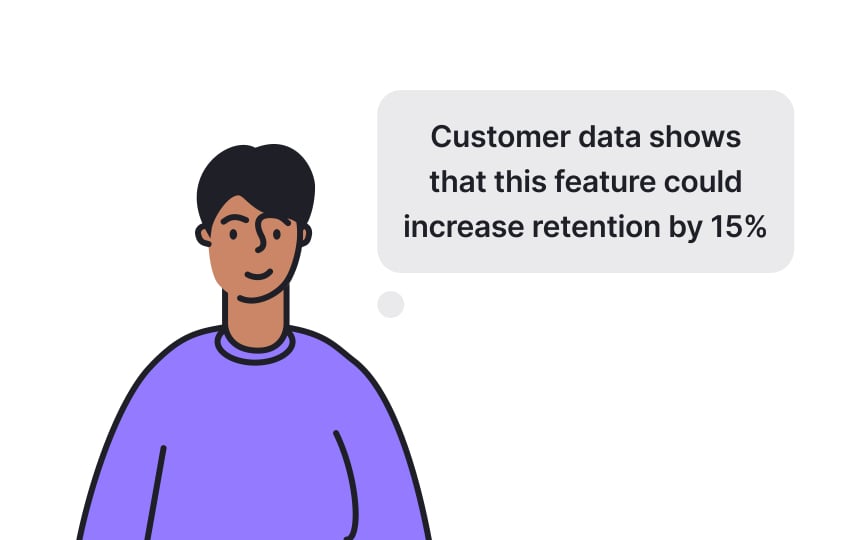Stakeholder Management
Build coalitions that transform resistance into support and drive your product forward
Stakeholder management is about working with everyone who cares about your product. That's your team, your boss, customers, partners, and yes, even that person in legal who always says no. The tricky part is that everyone wants something different. Your CEO wants revenue, your engineers want elegant code, and your users just want their problems solved. Good stakeholder management means figuring out what matters to each person and finding ways to get everyone moving in the same direction
Sometimes that means showing executives hard data. Other times it's sitting with customers to understand their frustrations. You'll need to know when to loop people in, how to share bad news without causing panic, and how to handle it when two important stakeholders want opposite things. The best product managers know how to turn skeptics into champions. They build relationships before they need them. They communicate in ways that resonate with different audiences. And they understand that managing stakeholders isn't about manipulation or politics. It's about creating shared understanding and momentum that helps great products actually ship.
Stakeholder mapping starts with identifying everyone who can impact or is impacted by your product. This includes obvious players like your development team and customers, but also less obvious ones like legal, compliance, or support teams. Missing a key stakeholder early can derail your product later.
Create a comprehensive stakeholder map by categorizing people based on their influence and interest in your project:
- High influence, high interest: Your champions and key decision makers who need weekly updates and direct involvement
- High influence, low interest: Executives or department heads who need executive summaries of major milestones
- Low influence, high interest: End users and team members who benefit from regular but simple updates
- Low influence, low interest: Peripheral teams who only need quarterly newsletters or company-wide announcements
Once mapped, document each stakeholder's role, their goals, and how your product affects them. Include their preferred communication style and frequency. Update this map regularly as projects evolve and new stakeholders emerge.
Every stakeholder has different motivations driving their involvement with your product. Sales teams care about features that close deals. Engineering wants technical excellence. Finance focuses on ROI. Understanding these motivations helps you frame your product in ways that resonate with each group.
However, always try and dig deeper than surface-level assumptions. A VP might say they want "innovation," but really they're worried about losing market share. Customer success might push for features not because users need them, but because it reduces support tickets. These hidden motivations often drive real decisions.
Build understanding through regular interactions, not just formal interviews. During project discussions, pay attention to what stakeholders repeatedly bring up or push back on. Notice which metrics they quote and what examples they use. Ask casual questions like "How does this impact your team's goals?" or "What would make your life easier here?" These natural conversations often reveal more than scheduled meetings. Over time, you'll understand their real priorities and can position your product accordingly.
Presenting to executives requires a different approach than typical product presentations. You have limited time, often just 15-30 minutes, to convey complex information and get decisions. Executives think in terms of business impact, competitive advantage, and resource allocation. Technical details usually aren't the focus.
Here are some tips to consider:
- Start with your recommendation and what you need from them. State this clearly in the first two minutes: "I'm seeking approval for X" or "I need a decision on Y." Then provide supporting evidence in order of importance. This "answer-first" approach respects their time and helps them process information efficiently.
- Keep presentations focused and visual. Every slide should directly support your ask. Use charts over tables, show trends not raw data, and highlight what matters for the decision.
- Have backup slides with plausible questions and supporting data ready but don't show them unless asked.
Remember, executives often form opinions quickly, so front-load your strongest points and be ready to skip to discussion at any moment.
Conflicting priorities are inevitable when multiple stakeholders have different goals. Sales wants features for the big prospect. Engineering wants to fix technical debt. Customer success needs bugs fixed. As a PM, you're often caught in the middle, trying to balance competing demands.
You can then use frameworks like RICE (Reach, Impact, Confidence, Effort) or value vs. effort matrices to make decisions objective. When conflicts arise, refer back to these shared criteria to guide discussions. The key is creating transparent prioritization criteria that stakeholders agree on upfront, based on a clearly defined product vision and product strategy. These, in turn, should align with the company’s overall vision and strategy and be accepted by all stakeholders.
When you must disappoint a stakeholder, acknowledge their priority's importance and explain the tradeoff clearly. Show them when their priority might be addressed. Sometimes you can find creative compromises that partially address multiple needs. Document these decisions so you're not rehashing the same debates repeatedly.
Trust isn't built through grand gestures but through consistent small actions. Follow through on commitments, even minor ones. If you say you'll send meeting notes by Friday, send them by Friday. Reliability in small things signals reliability in big things.
Build credibility by demonstrating competence in your domain. Come to meetings prepared. Understand the technical constraints and business context. When you don't know something, admit it and follow up with answers. Stakeholders respect honesty more than false confidence.
Share credit generously and own mistakes completely. When things go well, highlight the team's contributions. When things go wrong, take responsibility and focus on solutions. This approach builds loyalty and makes stakeholders more willing to support you during challenging times.
Alignment workshops bring diverse stakeholders together to reach consent or consensus on product direction.
Success depends on careful facilitation:
- Start by setting clear objectives and ground rules. Everyone should understand what decisions need to be made and how they'll be made.
- Use structured activities to drive productive discussions. Techniques like affinity mapping, dot voting, or "How Might We" exercises channel debate into actionable outcomes.[1]
- Time-box discussions to maintain momentum. When groups get stuck, use breaks strategically to let tensions cool.
- Document decisions and next steps in real-time where everyone can see them. This prevents revisionist history later.
- End workshops with clear action items, owners, and deadlines.
- Send follow-up notes within 24 hours while discussions are fresh.
The goal isn't just alignment in the room but sustained alignment afterward.
Stakeholder feedback comes from many channels: formal reviews, casual conversations, emails, and indirect comments through others. Without a system, valuable insights get lost and stakeholders feel ignored. Create a centralized way to capture, process, and respond to all feedback.
Acknowledge every piece of feedback within 48 hours, even if you can't act on it immediately. Explain how you'll evaluate it and when they can expect a fuller response. This simple acknowledgment shows stakeholders their input matters and prevents repeated follow-ups.
Close the loop on feedback by communicating what happened to it. Did it influence the roadmap? Why was it deprioritized? How did it shape your thinking? Stakeholders who see their feedback's impact are more likely to stay engaged and provide quality input in the future.
Product managers rarely have formal authority over stakeholders, yet need to drive outcomes across the organization. Influence comes from understanding what motivates people and aligning your goals with theirs. Find the win-win scenarios where helping you helps them.
Build influence through expertise and relationships. Become the go-to person for product insights. Share valuable information proactively. Help stakeholders solve their problems, even when not directly related to your product. These deposits in the "relationship bank" pay dividends later.
Use data and customer voices as your authority. Stakeholders might dismiss your opinion but can't ignore customer feedback or market data. Frame recommendations in terms of business impact. Instead of "I think we should," try "Customer data shows that this feature could increase retention by 15%."





















